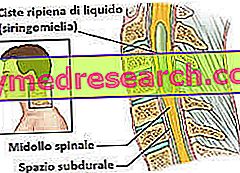Generality
Carpal tunnel syndrome is a fairly common nerve compression disorder that causes pain, numbness and tingling in the wrist, hand and fingers.
The cause is rarely one; in fact, carpal tunnel syndrome is usually the result of a combination of different circumstances.

A thorough physical examination is often enough to diagnose the disorder; however, in some cases, the doctor requires further checks to make sure there are no other pathologies in place.
The therapy can be conservative or surgical, depending on the severity and duration of the symptoms.
What is carpal tunnel syndrome?
Carpal tunnel syndrome is a disorder of the wrist and hand, which causes pain, numbness and tingling in the affected areas.
WHAT IS TUNNEL CARPALE?
The carpal tunnel is an arch-shaped osteo-ligament structure located between the inside of the wrist and the palm of the hand.
It is called a tunnel because it forms a narrow passage for nine tendons and for a nerve, sensitive and motor at the same time, called the median nerve .
Laterally and posteriorly to the carpal tunnel, there are the bones of the hand, also called carpal bones .

THE MEDIAN NERVE
The median nerve originates approximately at the level of the armpit, runs along the whole arm and, passing through the wrist, reaches the palm and fingers of the hand (excluding the little finger).
It has both a sensitive function, as it provides the tactile capabilities of the palm of the hand, and a motor function, as it allows the thumb, index, middle and part of the ring finger to be moved.
As shown by the figure, the median nerve passes through the carpal tunnel just below the main ligamentous structure.
Epidemiology
Carpal tunnel syndrome can affect anyone. However, according to various statistical studies, it occurs mainly in the middle-advanced age, ie around 45-60 years, and affects more women than men (in fact, the ratio is 3 to 1 for the female sex).
Causes
Carpal tunnel syndrome occurs when the median nerve, at the carpal tunnel level, undergoes a nerve compression such that it loses some of its sensory function and part of its motor function.
But what is the origin of the compression of the median nerve?
What is nerve compression?
The compression of a nerve, also called nerve compression, is a very particular condition in which a nerve, crushed by the surrounding tissues, becomes irritated, causes pain and loses some of its functions.
The nerves of the human body that can be subjected to this type of crushing are numerous, so much so that doctors have cataloged nerve compressions as real pathologies known as nerve compression syndromes .
In addition to carpal tunnel syndrome, other important nerve compression syndromes are: paresthesia meralgia, tarsal tunnel syndrome, radial tunnel syndrome, Morton's neuroma, etc.
RISK FACTORS

Figure: median nerve (in yellow) in the human being. As you can see, it starts at the armpit level and ends by completely innervating the thumb, the index and the middle finger. The ring finger is only half innervated (not highlighted here). A compression of the median nerve, which takes place in the carpal tunnel, reduces the tactile capacity and the motor functions of the hand. From the site: aboutwristpain.com
The observation of many clinical cases has led to the identification of a link between carpal tunnel syndrome and certain favoring situations. These circumstances, which almost always act in combination and only rarely individually, concern:
- Anatomical factors . People with a very narrow carpal tunnel are more likely to develop the homonymous syndrome. However, it is not an unavoidable condition, since there are individuals with very tight wrists who are fine and have never suffered from any disturbance to the median nerve.
- Sex . According to statistics collected in most parts of the world, carpal tunnel syndrome is more common among women. The reason, however, has not yet been clarified.
- Family history . The researchers noted that in some families carpal tunnel syndrome is a recurrent disorder, transmitted from generation to generation. The hypothesis of a possible inheritance of this pathology is interesting, but it still remains to be tested from the biological-molecular point of view
- Particular pathological conditions . According to various sources, certain pathologies, such as diabetes, rheumatoid arthritis, gout, obesity, chronic water retention, renal insufficiency and hypothyroidism, would favor the appearance of carpal tunnel syndrome.
- Pregnancy . The incidence of carpal tunnel syndrome among pregnant women is very high. The precise reason has not yet been fully clarified, however, according to some researchers, there seems to be a link with the phenomenon of water retention, which usually characterizes the last months of pregnancy. Once the birth has taken place, the nerve compression disorder resolves spontaneously, within a week.
- Traumas and injuries . Traumas and fractures of the wrist modify the anatomical structure of the carpal tunnel and, inevitably, also of the space within which tendons and median nerves pass. This could involve nerve compression or tendon degeneration.
- Repetitive work / manual activities . Although no scientific evidence exists at this time, it appears that, in some individuals, the repetition of certain hand movements or certain manual work results in microtrauma on the wrist and a compression of the median nerve by the carpal tunnel. Among the potentially responsible activities, we note the three, perhaps, the most debated: playing a musical instrument, using vibrant working tools (chainsaw, jackhammer, etc.) and using the computer for many hours a day.
Symptoms and Complications
To learn more: Carpal Tunnel Syndrome Symptoms
Carpal tunnel syndrome affects the wrist, the palm of the hand and the fingers controlled by the median nerve (ie thumb, index, middle and part of the ring finger).
There are three main symptoms:
- Tingling
- Sense of numbness
- Ache
They appear gradually, never suddenly, and tend to worsen in two situations: during the night, perhaps due to involuntary bending of the wrist, and continually straining the affected joints.
OTHER SYMPTOMS
In addition to tingling, numbness and pain, carpal tunnel syndrome can give rise to other symptoms such as:
- Dull pain in the forearm and arm
- Paresthesia of the affected limb (general tingling sensation associated with burning sensation)
- Dry skin, swelling, and skin color changes
- Hypoesthesia, or reduction of sensitivity
- Difficulty to bend the thumb
- Weakening of the muscles ( atrophy ) that govern the movement of the thumb
- Difficulty in gripping objects and performing certain manual actions, such as writing, typing text on a computer etc.
In the same way as the three main symptoms, these manifestations also worsen if the wrist and hand joints are continually bent and subjected to tension.
Diagnosis
In most cases, the doctor diagnoses carpal tunnel syndrome with a thorough physical examination and with a meticulous assessment of the patient's medical history and habits.
However, in some rare circumstances, it has to resort to more specific tests - such as electromyography - to make sure that the disorders are not due to different causes.
EXAMINATION OBJECTIVE
During the physical examination, the doctor first analyzes the patient's wrist and hand; after which, he asks the latter to describe the symptoms felt, which toes are sore and to make certain movements, to have him describe what he feels and to see the functionality of the hand.
Finally, he questions the patient about his medical history (past medical conditions, current health status, surgical operations, etc.), his work and hobbies, looking for a circumstance favoring carpal tunnel syndrome.
Physical examination: some important observations
- What movements exclude carpal tunnel syndrome?
The little finger is not controlled by the median nerve; therefore a pain or a motor difficulty exclusively at his / her expense excludes the carpal tunnel syndrome.
- What movements or tests are performed to try to reproduce the classic symptoms of carpal tunnel syndrome?
A classic movement is repeated wrist flexion for at least a minute; a test, instead, very indicative, is to ask the patient to tighten his wrist, in correspondence of the carpal tunnel, and to describe what he feels.
OTHER TESTS
If the doctor is not convinced by the physical examination or believes that behind the carpal tunnel syndrome some more dangerous pathology can be hidden (for example a form of diabetes of which the patient does not know the existence), he can subject the subject to further controls.
The table shows the possible exams and a brief description of them.
| Exam | Description |
| Nerve conduction study or electronurography | It is the exam that detects how fast the transmission of nerve signals is. In the specific case, the procedure involves the use of two electrodes, which, positioned one on the hand and one on the arm, stimulate the median nerve to diffuse a nervous signal. If the nerve signal slows down when it crosses the carpal tunnel, there is a good chance that it is a nerve compression at this level. It is a very effective test, which serves to remove all doubt. |
| Electromyography | The electromyography allows to measure the natural electrical activity of the muscles, inserting one or more electrodes on the affected area. In the case of carpal tunnel syndrome, it is performed to rule out the existence of muscle damage. It is less indicative of electroneurography and, in fact, is performed more rarely. |
| X-ray | The X-ray X-ray examination is performed only if the physical examination has revealed the suspicion of a wrist fracture or a degenerative joint disorder, such as rheumatoid arthritis. |
| Blood tests | The doctor prescribes a thorough blood test when he fears that, at the origin of carpal tunnel syndrome, there is a form never diagnosed before diabetes, hypothyroidism, gout or rheumatoid arthritis. |
Treatment
The therapeutic treatment for carpal tunnel syndrome depends on the severity and duration of symptoms.
In fact, the therapy is conservative (ie non-surgical ) when the median nerve disorders are moderate, bearable and present for a few months; it is instead surgical when the symptomatology is intense, such as to affect daily life, and in progress for at least 6 months.
It should be remembered that, in some situations, favoring factors are also important: for example, the treatment of diabetes or rheumatoid arthritis can have good results on carpal tunnel syndrome; just as the rest of the joints of the wrist and hands has discrete effects.
CONSERVATIVE THERAPY
The conservative therapy provided for carpal tunnel syndrome consists substantially in the application of a wrist brace and in the administration of corticosteroid drugs.

- Corticosteroids . Corticosteroids are powerful anti - inflammatory drugs. They can be administered either by mouth or via a local injection into the painful wrist. Their prolonged use can have serious side effects, such as hypertension, osteoporosis, weight gain, etc. Therefore, if the treatment does not take effect, it is advisable to ask the doctor for advice about what to do.
To learn more: Medications for the treatment of carpal tunnel »
Two tips to follow: rest and ice
Patients who have the ability to rest their suffering wrist and apply ice will significantly improve their condition.
With rest, in fact, stress is relieved at the joint, while with ice packs the painful sensation and swelling (when present) are reduced.
SURGERY
When to intervene surgically. Surgery is only considered when the symptoms of carpal tunnel syndrome are intense, unbearable and present for at least 6 months.
Mode. The operation is ambulatory, therefore it is performed during the day and does not include any hospitalization; requires local anesthesia, so the patient is conscious ; it can be " open-air " or " closed-air ". In the open air it means that the surgeon intervenes on the median nerve by making an incision of several centimeters on the wrist, at the carpal tunnel; on the other hand, it means that the surgeon performs the arthroscopy operation . The choice between proceeding in the open or closed sky is generally the responsibility of the doctor in charge.
Post-operative phase. Once operated, the patient must keep his wrist bandaged for a couple of days; after which he can wear a brace and begin the first rehabilitation exercises. The latter is essential to recover the full functionality of the wrist.
Complications and risks of the intervention. Although not very frequent, surgery can cause: infections, blood loss (bleeding), permanent damage to the operated median nerve, scars, etc. The possibility of a reappearance of symptoms after surgery ( recurrence ) is quite rare.
Prognosis. According to Anglo-Saxon statistics, more than half of patients undergoing surgery recover with satisfactory results.
To learn more: Carpal tunnel surgery »
Prevention
Because it seems that carpal tunnel syndrome is linked to certain work activities, it may be useful:
- Reduce the force with which certain operations are performed . Often, certain manual activities are performed, without wanting to, with more force than necessary. Changing this attitude could alleviate tension in the wrist and hand joints.
- Take frequent breaks . During manual work, especially the very strenuous and stressful ones, it is good to take frequent breaks. This allows, as in the previous case, to relieve tension on the hand and wrist.
- Improve general body posture . An incorrect shoulder and neck posture affects the rest of the body, including arms and hands.
- Keep the suffering hand warm . The heat guarantees a good flexibility of the hand. If you work outdoors in the winter season, it can be useful to wear gloves without fingers.
- Pay attention to the position of the wrist . It is good practice to set up the work station in such a way as to avoid the most uncomfortable and stressful positions on the wrist. For example, those who spend many hours at the computer should keep the keyboard at the level of the elbows or lower.
Attention : readers should be reminded that the correlation between manual activity and carpal tunnel syndrome has not yet been confirmed by any scientific evidence.
To learn more: Remedies for carpal tunnel syndrome »




